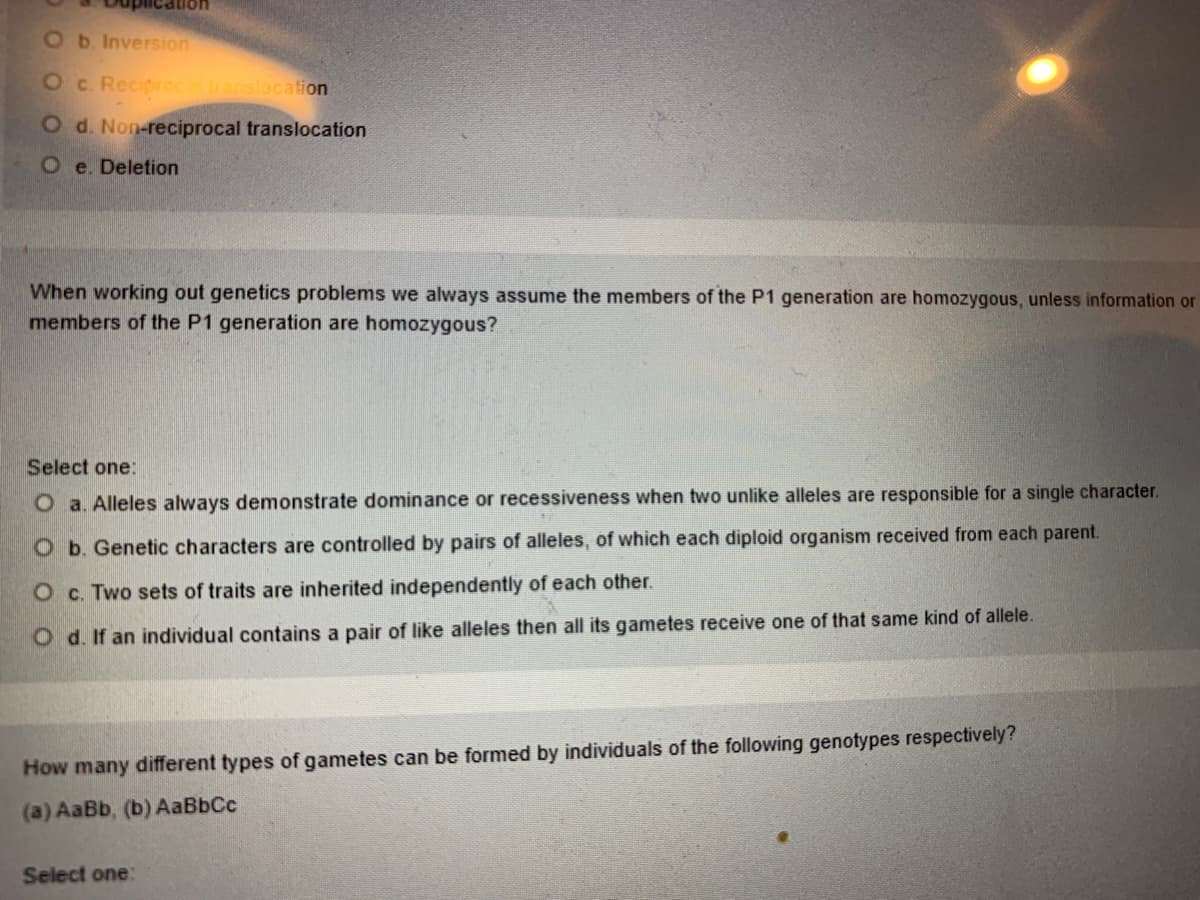When working out genetics problems we always assume the members of the P1 generation are homozygous, unless information or members of the P1 generation are homozygous? Select one: O a. Alleles always demonstrate dominance or recessiveness when two unlike alleles are responsible for a single character. O b. Genetic characters are controlled by pairs of alleles, of which each diploid organism received from each parent. O c. Two sets of traits are inherited independently of each other. O d. If an individual contains a pair of like alleles then all its gametes receive one of that same kind of allele.
When working out genetics problems we always assume the members of the P1 generation are homozygous, unless information or members of the P1 generation are homozygous? Select one: O a. Alleles always demonstrate dominance or recessiveness when two unlike alleles are responsible for a single character. O b. Genetic characters are controlled by pairs of alleles, of which each diploid organism received from each parent. O c. Two sets of traits are inherited independently of each other. O d. If an individual contains a pair of like alleles then all its gametes receive one of that same kind of allele.
Biology: The Unity and Diversity of Life (MindTap Course List)
14th Edition
ISBN:9781305073951
Author:Cecie Starr, Ralph Taggart, Christine Evers, Lisa Starr
Publisher:Cecie Starr, Ralph Taggart, Christine Evers, Lisa Starr
Chapter13: Observing Patterns In Inherited Traits
Section: Chapter Questions
Problem 7GP: Several alleles affect traits of roses, such as plant form and bud shape. Alleles of one gene govern...
Related questions
Question
Which of the postulates was not based on the results that all members of p1 generation are homozygous

Transcribed Image Text:Ob. Inversion
Oc. Reciprocalranslocation
O d. Non-reciprocal translocation
O e. Deletion
When working out genetics problems we always assume the members of the P1 generation are homozygous, unless information or
members of the P1 generation are homozygous?
Select one:
O a. Alleles always demonstrate dominance or recessiveness when two unlike alleles are responsible for a single character.
O b. Genetic characters are controlled by pairs of alleles, of which each diploid organism received from each parent.
O c. Two sets of traits are inherited independently of each other.
O d. If an individual contains a pair of like alleles then all its gametes receive one of that same kind of allele.
How many different types of gametes can be formed by individuals of the following genotypes respectively?
(a) AaBb, (b) AaBbCc
Select one:
Expert Solution
Step 1
Gregor Johann Mendel selected seven pairs of true-breeding varieties of pea as a starting material for his experiment. They formed the P1 generation having plants that are usually homozygous for one or more traits and are also used to perform the first cross of the genetic experiment.
Step by step
Solved in 3 steps

Knowledge Booster
Learn more about
Need a deep-dive on the concept behind this application? Look no further. Learn more about this topic, biology and related others by exploring similar questions and additional content below.Recommended textbooks for you

Biology: The Unity and Diversity of Life (MindTap…
Biology
ISBN:
9781305073951
Author:
Cecie Starr, Ralph Taggart, Christine Evers, Lisa Starr
Publisher:
Cengage Learning

Human Heredity: Principles and Issues (MindTap Co…
Biology
ISBN:
9781305251052
Author:
Michael Cummings
Publisher:
Cengage Learning

Biology: The Unity and Diversity of Life (MindTap…
Biology
ISBN:
9781337408332
Author:
Cecie Starr, Ralph Taggart, Christine Evers, Lisa Starr
Publisher:
Cengage Learning

Biology: The Unity and Diversity of Life (MindTap…
Biology
ISBN:
9781305073951
Author:
Cecie Starr, Ralph Taggart, Christine Evers, Lisa Starr
Publisher:
Cengage Learning

Human Heredity: Principles and Issues (MindTap Co…
Biology
ISBN:
9781305251052
Author:
Michael Cummings
Publisher:
Cengage Learning

Biology: The Unity and Diversity of Life (MindTap…
Biology
ISBN:
9781337408332
Author:
Cecie Starr, Ralph Taggart, Christine Evers, Lisa Starr
Publisher:
Cengage Learning